Customize cards on a sprint taskboard in Azure Boards
TFS 2017 | TFS 2015
Sprint Taskboards are similar to Kanban boards in that they show work items as cards instead of as lists. They're different in the ways summarized in Backlogs, Boards, and Plans. Similar to the Kanban boards, you can customize cards. To change column names or add columns, you need to customize the workflow.
Note
This article addresses customization of a sprint Taskboard. For information on customizing a Kanban board, see Manage and configure team tools.
Prerequisites
- You must have a sprint Taskboard you want to configure. When you add a team, you add a Taskboard for every sprint that you select for your team. To learn more, see About teams and Agile tools.
- To add or rename columns, or customize cards, you must be added to the team administrator role for the team's settings you want to modify, or be a member of the Project Administrators security group. To get added, see Add a team administrator or Change project-level permissions.
Taskboard customization options
To add or remove columns, choose Column Options. You customize all other options through the Settings dialog for the Taskboard.
Important
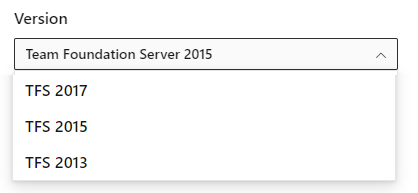
To view the content available for your platform, make sure that you select the correct version of this article from the version selector which is located above the table of contents. Feature support differs depending on the on-premises version of TFS you are using. .
To learn which on-premises version you are using, see What platform/version am I using?
Option
Use to...
Manage bugs on Taskboard similar to tasks.
Add or remove fields from cards.
Add styling rules to change card color and title style based on field criteria.
Note
Each team can customize their Taskboard columns and cards. Taskboard settings are not inherited from other teams that they may share portions of area paths.
Understand the Taskboard customization sequence
Before you configure your Taskboard, you'll want to make sure the following tasks are as complete as possible. Otherwise, you'll find yourself revisiting your configuration.
Process Administrator:
- Add custom work item types that you want to appear on your Taskboard. For details, see Add and manage work item types.
- Customize your iteration backlog to ensure all work item types you want to have will appear on the Taskboards. For details see Customize backlogs & boards.
- Customize each work item type to have any custom fields you want to show. For details, see Customize a workflow.
Note
You can customize a work item type which is different then customizing the card displayed on the Taskboard. You customize a WIT by adding fields, changing the workflow, adding custom rules and more. You can also add custom work item types and custom backlog levels. For details, see Customize the On-premises XML process model.
Team Administrator:
- Meet with your team and determine how the team wants to manage bugs, similar to requirements or tasks.
- Add any tags to work items that you want to use to support styling rules.
Show bugs on your taskboard
If you want bugs to appear on your taskboard, change your team settings for show bugs on the backlogs and boards.
Add fields to cards on a sprint taskboard
Scrum teams use the Taskboard to burn down work and report on progress during daily stand ups. Each sprint Taskboard shows cards that correspond to both requirements and tasks.
Provide information-rich cards
Information rich cards not only provide at-a-glance information of interest to you and your team. They also provide a way for you to update a field without opening the work item. And, with style rules, you can highlight those work items with select colors based on the criteria you set.
Each card corresponds to a work item that you use to share information, track status, and assign work.
Note
To understand the differences between backlogs, boards, taskboards, and Delivery plans, see Backlogs, boards, and plans. If your backlog or board doesn't show the work items that you expect or want, see Set up your backlogs and boards.
In this example, the bug work item type (WIT) shows all the core fields. It also shows three other fields and tags. To make severity 1 bugs stand out, a styling rule has been added to cause the card to display as yellow.
In the card shown below, the following customizations have been set for the task work item type (WIT):
- Show all core fields: ID, Assigned To, Remaining Work, Tags
- Show three additional fields: Priority
- Apply styling rule to display tasks with Priority=1 as green
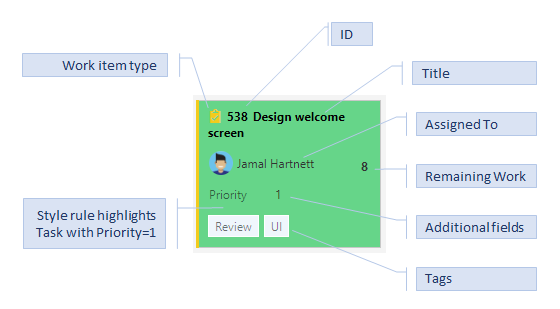
You can either increase or simplify the information that displays on your cards. It all depends on what's of interest to your team. Does your team like to refer to work items by their ID? Do they want to see estimates? Do they want to highlight work items according to set criteria? Or, will just the bare bones of title and assignment suffice?
Your best bet is to show fields on cards based on what your team frequently refers to. Or, you can show fields based on updates when using the Taskboards. Also, add fields with information that you can use to filter the board. If you're new to working with these tools, see Sprint planning.
Add or remove fields from cards on the Taskboard
You change the way cards appear on the Taskboard in the same way you change the appearance of cards on Kanban boards. Only here, you start from the Taskboard.
Open the taskboard for the sprint you want to customize. Remember, only team or project administrators can customize the taskboard.
Choose the
 gear icon to open the Settings dialog.
gear icon to open the Settings dialog.
Choose Fields and then a work item type to see all the settings you can modify.
Place a check mark in the check box for those fields you want to have appear on the board.
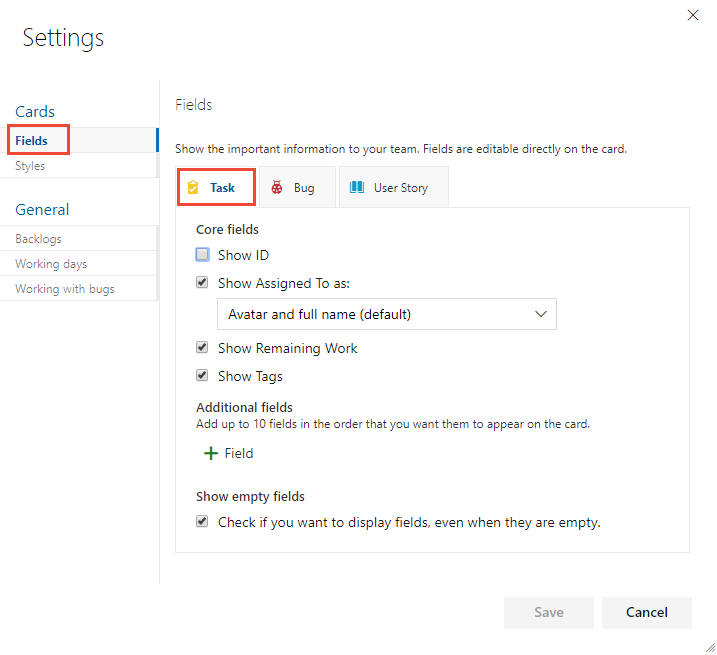
Repeat this step for each work item type you want to change. Don't be surprised if the options change when you choose a different work item type. For example, Show Remaining Work only applies to tasks and perhaps bugs, but not to user stories or product backlog items.
To add a field, choose the
 plus icon and enter the name of a field you want to add.
plus icon and enter the name of a field you want to add.To remove a field, choose the
 delete icon next to the field.
delete icon next to the field.When done with your changes, choose Save.
Update fields from cards
Using the board views provides you with quick and easy ways to update work items as work progresses. Making daily or frequent updates helps everyone on your team stay in sync with what's been done and what needs doing next.
To update status of a work item, you simply drag-and-drop cards to a different column. To change the order or stack ranking of a work item, you drag a card up or down within a column.
Moving the card from In Progress to the Done column on the Task board, for example, updates the corresponding State field. In this case, the State field updates from Doing to Done.

Another handy feature is to update a field without having to open the work item. You can update most fields shown on the card. Here we reassign a task.
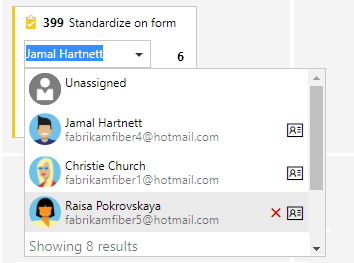
This quick update feature is useful when you need to update many work items at once. For example, you can add estimates or update Remaining Work.
To change the title, choose the ![]() actions icon, and then choose Edit title.
actions icon, and then choose Edit title.
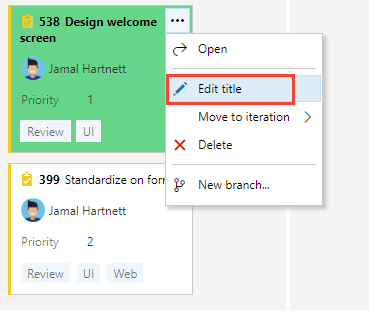
To add tags, double-click the work item to open it. And, just a reminder, you can't change the IDs for a work item, not from the card and not from within the form.
Define style rules, highlight cards
With styling rules, you can cause cards to change color when their corresponding work items meet criteria that you set. Here, we highlight Priority 1 tasks by having the cards display as green.
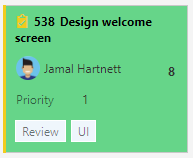
Example styling rules
What rules should you apply to highlight work items? Here are a few examples and their associated criteria.
| Work items | Criteria |
|---|---|
| High priority items | Priority = 1 |
| High effort items | Remaining Work>=12 |
| Stale items unchanged in the last 5 days | Changed Date @Today-5 |
| Title contains a key word | Title Contains Yes |
| Severity 1 bugs | Severity = 1 - Critical AND Work Item Type = Bug |
| High value business items | Business Value 50 |
| Items assigned to specific feature area | Area Path Under Fabrikam Fiber\Phone |
| Contains specific tag | Tags Contain RTM |
| Blocked tasks (Scrum process only) | Blocked = Yes |
Add or remove a style rule
You can apply style rules to change the color of Taskboard cards based on specified field criteria.
Open the Taskboard that you want to customize. If you're not a team admin, get added as one. Only team and project admins can customize boards.
Choose the
 gear icon to open the Settings dialog.
gear icon to open the Settings dialog.Choose Styles to specify a style rule. Choose the
 plus icon to add a style. Select the color to apply to the card and define the criteria for the style rule.
plus icon to add a style. Select the color to apply to the card and define the criteria for the style rule.In this example, we show the Styles dialog for the taskboard.
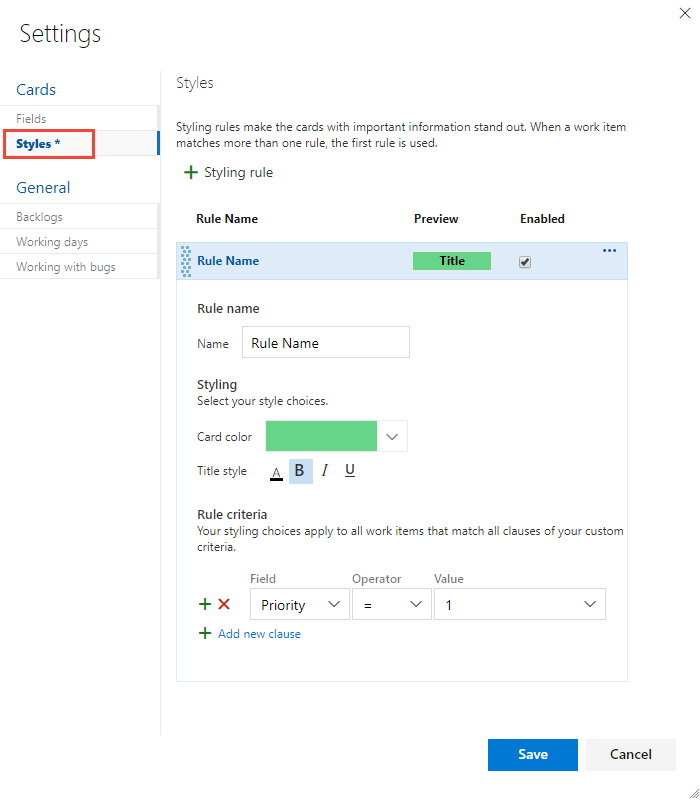
Follow these rules when creating and ordering your style rules:
The criteria you specify works in a similar fashion as when constructing a query
All clauses are considered AND clauses, grouping clauses isn't supported
Card rules apply to all work items that meet the rule criteria
Rule color applies to work items based on the order in which rules are listed. If you add more than one style rule, make sure that you move them in the order of most importance. Drag them into the order you want them applied.
You can quickly enable and disable a style rule
Here we add a Stale tasks rule that highlights tasks that haven't changed in the last five days.
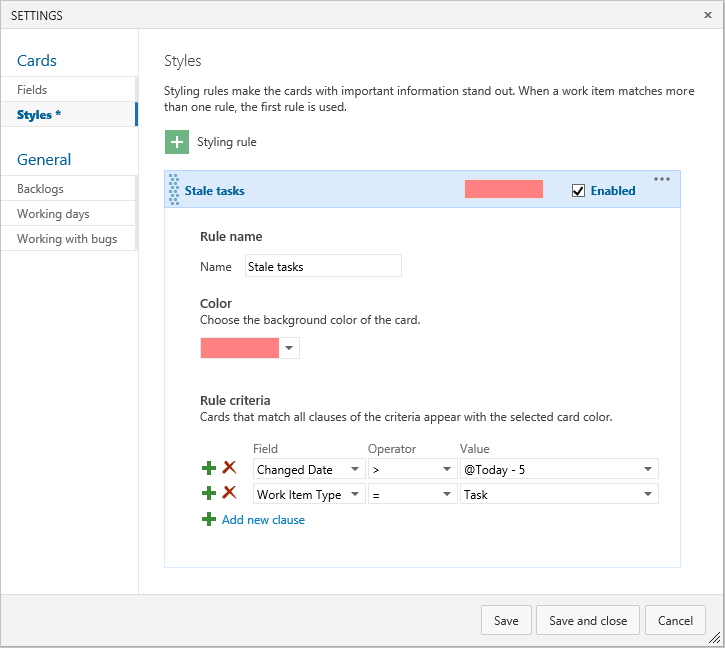
To copy or delete a style rule, choose the
 actions icon and select Clone or Delete, respectively.
actions icon and select Clone or Delete, respectively.When done with your changes, choose Save.